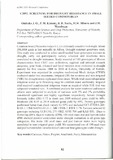Screening for drought resistance in small seeded common bean

View/
Date
2011-09Author
Wambugu, J. M.
Mburu, M. W.
Narla, R. D,
Kimani, P. M.
Ombaka, J. O.
Language
enMetadata
Show full item recordAbstract
Common bean (Phaseolus vulgaris L.) is extremely sensitive to drought. About
396,000t grain is lost annually in Africa. Drought resistant genotypes exist.
This study was conducted to select small seeded bean genotypes resistant to
drought, carry out participatory variety selection and determine traits
associated to drought resistance. Study material of 160 genotypes of diverse
characteristics from CIAT core collections, regional and national research
programs, gene bank, released and local varieties were evaluated in drought
nursery for five seasons 2008 to 2010 at Kabete, University of Nairobi.
Experiment was organized in complete randomized block design (CRBD)
evaluated under two treatments, irrigated (lR) for no stress and non-irrigated
(NIR) for drought stress replicated three times. Whole trial received sprinkler
irrigation water up to flowering stage to establish stand uniformity. Irrigated
trial received supplemental irrigation water as required while NIR trial was
subjected to natural rain. A combined analysis for water treatment and season
effects were subjected to analysis of variance with 5% and 1% probability
considered significant and highly significant respectively. Severe Drought
Intensity Index (DII) 0.72 in short rain 2009 reduced grain yield by 60%.
Moderate DII 0.45 in 2010 reduced grain yield by 40%. Twenty genotypes
performed better than check variety by 55% and included GCI-ZEBRA-268-
RAR-1, CIM-NAV02-02-11-1, MR 13508-7, RWR 2178. Farmers selected 12
genotype including GCI-CAL 271-AR2, AFRI 708 and KAB 150. Days to
flowering (DF), days to maturity (DM), 100 seed mass and pod harvest index
(PHI showed positive correlation under drought evaluation in all grain type
categories. The traits 100 seed mass and pod harvest index were highly
correlated to non-irrigated grain yield. We recommend use of 100 seed mass
and pod harvest index for selection of common bean genotypes under drought.
Citation
Optimimization of Agricultural Value Chains for sustainable DevelopmentSponsorhip
National Council of Science and Technology, The Kenya Seed CompanyPublisher
Faculty of Veterinary Medicine, University of Nairobi
Description
aGRO 2011 Biennial Conference presentation
